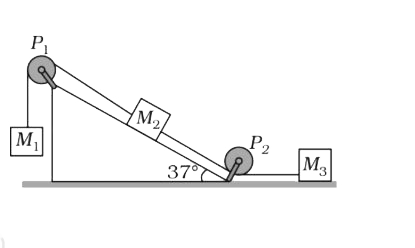For the redox reaction
xCr(OH)3+YlO−3+zOH−→xCrO2−4+yl−+5H2Othe sum of the stoichiometric coefficient (x+y+z) is equal to
The correct Answer is:7
To solve the redox reaction given by the equation:
xCr(OH)3+yIO−3+zOH−→xCrO2−4+yI−+5H2O
we need to determine the stoichiometric coefficients x, y, and z and then find the sum x+y+z.
Step 1: Determine the oxidation states
1. Chromium in Cr(OH)3:
- The hydroxide ion (OH) has a charge of -1, and there are 3 OH groups.
- Let the oxidation state of Cr be x.
- The equation becomes:
x+3(−1)=0
x−3=0
x=+3
- Thus, the oxidation state of Cr in Cr(OH)3 is +3.
2. Chromium in CrO4^{2-}:
- Let the oxidation state of Cr in CrO4^{2-} be y.
- Each oxygen has a charge of -2 and there are 4 oxygens:
- The equation becomes:
y+4(−2)=−2
y−8=−2
y=+6
- Thus, the oxidation state of Cr in CrO4^{2-} is +6.
Step 2: Determine the change in oxidation state
- The change in oxidation state for Cr is from +3 to +6, which means it loses 3 electrons (oxidation).
Step 3: Analyze the iodine species
1. Iodine in IO3^-:
- Let the oxidation state of I in IO3^- be z.
- The equation becomes:
z+3(−2)=−1
z−6=−1
z=+5
- Thus, the oxidation state of I in IO3^- is +5.
2. Iodine in I^-:
- The oxidation state of I in I^- is -1.
Step 4: Determine the change in oxidation state for iodine
- The change in oxidation state for I is from +5 to -1, which means it gains 6 electrons (reduction).
Step 5: Balance the electrons
- To balance the electrons transferred:
- Chromium loses 3 electrons.
- Iodine gains 6 electrons.
- Therefore, we need to multiply the chromium reaction by 2 to balance the electrons:
2Cr(OH)3+1IO−3+zOH−→2CrO2−4+1I−+5H2O
Step 6: Determine the stoichiometric coefficients
- From the balanced equation:
- x=2 (for Cr(OH)3),
- y=1 (for IO3^-),
- z=4 (for OH^-).
Step 7: Calculate the sum of stoichiometric coefficients
- Now, we can find the sum:
x+y+z=2+1+4=7
Final Answer
The sum of the stoichiometric coefficients x+y+z is equal to 7.
---
- The hydroxide ion (OH) has a charge of -1, and there are 3 OH groups.
- Let the oxidation state of Cr be x.
- The equation becomes:
x+3(−1)=0
x−3=0
x=+3
- Thus, the oxidation state of Cr in Cr(OH)3 is +3.
- Let the oxidation state of Cr in CrO4^{2-} be y.
- Each oxygen has a charge of -2 and there are 4 oxygens:
- The equation becomes:
y+4(−2)=−2
y−8=−2
y=+6
- Thus, the oxidation state of Cr in CrO4^{2-} is +6.
- Let the oxidation state of I in IO3^- be z.
- The equation becomes:
z+3(−2)=−1
z−6=−1
z=+5
- Thus, the oxidation state of I in IO3^- is +5.
- The oxidation state of I in I^- is -1.
- Chromium loses 3 electrons.
- Iodine gains 6 electrons.
- Therefore, we need to multiply the chromium reaction by 2 to balance the electrons:
2Cr(OH)3+1IO−3+zOH−→2CrO2−4+1I−+5H2O
- x=2 (for Cr(OH)3),
- y=1 (for IO3^-),
- z=4 (for OH^-).
x+y+z=2+1+4=7
Similar Questions
In the reaction Cl2+OH−→ClO−3+Cl−+H2O the stoichiometric coefficient of Cl2 and Cl− respectively are
View SolutionFor the redox reation
MnO−4+C2O2−4+H+→Mn2+CO2+H2O
The correct stoichiometric coefficients of Mno−4,C2O2−4 and H+ respectively:View SolutionAssertion (A) : For the reaction
H2+I2⇔2HI,Kp=Kc
Reason (R) : In this reaction, the sum of stoichiometric coefficient of reactants is equal to the sum of stoichiometric coefficients of products.View SolutionMasses M1,M2 and M3 are connected by strings of negligible mass which pass over massless and frictionless pulleys P1 and P2 as shown in the figure. The masses move such that the portion of the string betweenP1 and P2 is parallel to the inclined plane and the portion of the string between P2 and M3 is horizontal. The masses M2 and M3 are 4.0 kg each and the coefficient of kinetic friction between both the masses and the surfaces is 0.25. The inclined plane makes an angle of 37° with the horizontal. If the mass M1 moves downwards with a uniform velocity, find
(i) the mass of M1 in kg
(ii) the tension in the horizontal portion of the string in Newton
 View Solution
View SolutionFor the redox reaction
xFe2++yCr2O2−7+zH+→Fe3++Cr3++H2O
x, y and z areView SolutionFor the redox reaction
MnO_(4)^(ө)+C_(2)O_(4)^(2-)+H^(o+)rarrMn^(2+)+CO_(2)+H_(2)O
the correct coefficients of the reactions for the balanced reaction areView SolutionFor the redox reaction:
Cr2O2−7+H⊕+Ni→Cr3++Ni2+H2O
The correct coefficient of the reactants for the balanced reaction are:View SolutionConsider the following equations :
2Fe2++H2O2(in basic medium)→xA+yB
2MnO−4+6H++5H2O2(in acidic medium)→x'C+y'D+z'E
The sum of the stoichiometric coefficients
x,y,x'y'andz' for products A, B, C, D and E, respectively, is ___________.View SolutionFor the redox reaction: Fe2++Cr2O2−7+H+→Fe3++Cr3++H2O The correct coefficients of the reactants for the balanced reaction are
View SolutionFor the redox reaction, MnO−+4C2O2−4+H+→Mn2++CO2+H2O the correct coefficients of the reactants for the balanced reaction are respectively MnO−4,C2O−4,H+ :
View Solution

